|
by
Fiona
Kelleghan
Talk
held at the International Conference on the Fantastic in the Arts
21 March 1996.
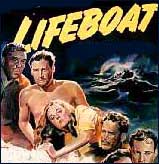 Composer
David Raksin says that Alfred Hitchcock wanted no music for
the 1944 film Lifeboat, because the characters are
''out on the open ocean. Where would
the music come from?'' Raksin replied, ''Go back and ask him where
the camera comes from and
I'll tell him where the music comes from!'' (Kalinak
xiii). Composer
David Raksin says that Alfred Hitchcock wanted no music for
the 1944 film Lifeboat, because the characters are
''out on the open ocean. Where would
the music come from?'' Raksin replied, ''Go back and ask him where
the camera comes from and
I'll tell him where the music comes from!'' (Kalinak
xiii).
Director John Carpenter,
who creates and performs the music for almost all of his own films,
agrees that the soundtrack should be
implicit. ''[Y]ou shouldn't be aware of what I'm doing. Yeah,
when it's scary or action-filled, you'll hear it, and it's fine.
But you shouldn't be sitting
there listening to music, or aware of it. It should be working
on you. ... I don't want you to be aware of the
technique. I just want you to feel it'' (Droney
118).
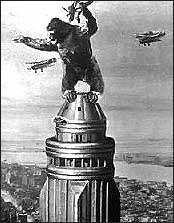 Sometimes
the composer does want you to be aware of his technique. The
most obvious soundtrack technique, known as ''mickeymousing,''
is just barely considered respectable by respectable film composers.
Mickeymousing is when the music blatantly
matches the action. When King Kong climbs the Empire State building,
the music likewise rises and falls with each of his
movements. In what has become a cliché, mickeymousing even
has the music giving away the action about to happen (Bazelon
24). A heavy brass chord announces danger; a low, sustained
tone creates mystery; sliding intervals of gliding strings
imply seductiveness. This musical
signal, that prepares the audience for the dramatic events to
follow, is known as the stinger. Sometimes
the composer does want you to be aware of his technique. The
most obvious soundtrack technique, known as ''mickeymousing,''
is just barely considered respectable by respectable film composers.
Mickeymousing is when the music blatantly
matches the action. When King Kong climbs the Empire State building,
the music likewise rises and falls with each of his
movements. In what has become a cliché, mickeymousing even
has the music giving away the action about to happen (Bazelon
24). A heavy brass chord announces danger; a low, sustained
tone creates mystery; sliding intervals of gliding strings
imply seductiveness. This musical
signal, that prepares the audience for the dramatic events to
follow, is known as the stinger.
The modern audience has become
sophisticated enough to be conscious of these musical cues. The
recognition value of really
successful music like the Jaws
and Psycho themes allows them to be parodied. James Homer's
soundtrack for Aliens makes musical
allusions to Capricorn One and Star Wars (Karlin
151), and it is parodied, in its turn, by Evil Dead
III: Army of Darkness.
In comedy films, composers can also use contrapuntal music that
plays directly against the textual theme. When Stanley
Kubrick introduces the song ''Try a Little Tenderness'' to accompany
two planes refueling in midair at the beginning of Dr.
Strangelove, he makes a joke that contrasts with the dark and
deadly implications of the rest of the film (Bazelon
112).
Where do composers get their
ideas from? Different musical instruments and noises create different
emotional impacts, so a lot of
their work is already done for them. Music has power to affect
the visual field and the imagination.
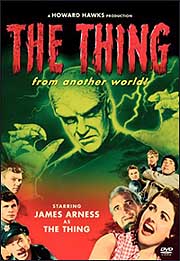 Synthesizers
are almost always used in SF and horror films because they
can produce otherworldly sounds. But for straightforward
emotion, horns are used too. These are associated with pageantry,
the military, and the hunt, so they are used to
suggest heroism. Movies featuring death-defying heroes such as
Star Wars and RoboCop use a lot of horns (Kalinak
13). Such triumphant
music implies certain guarantees, however. Carpenter says that
for his version of The Thing, he insisted on
grim music: ''If we had made the
audience feel that we were in a heroic situation, that movie would
be a cheat. ... When they hear
that heroic sound they go, Oh, okay, everything's going to be
all right. But it's not going to be all right ...!'' (Droney
118). Synthesizers
are almost always used in SF and horror films because they
can produce otherworldly sounds. But for straightforward
emotion, horns are used too. These are associated with pageantry,
the military, and the hunt, so they are used to
suggest heroism. Movies featuring death-defying heroes such as
Star Wars and RoboCop use a lot of horns (Kalinak
13). Such triumphant
music implies certain guarantees, however. Carpenter says that
for his version of The Thing, he insisted on
grim music: ''If we had made the
audience feel that we were in a heroic situation, that movie would
be a cheat. ... When they hear
that heroic sound they go, Oh, okay, everything's going to be
all right. But it's not going to be all right ...!'' (Droney
118).
The length of a sound from
its beginning to its peak is called attack, which may be fast
(like a door slamming) or slow (like a dog
growling). Fast attack sounds loud. Loud sounds are more frightening
than soft sounds, and sudden loud sounds are the most
frightening of all. If you are shooting a scene about a woman
alone in a house on a stormy night and you want to show
how terrified she is of the situation,
one way is to use loud claps of thunder. When old radio mystery
shows wanted to suggest
someone alone in a dark house with
a killer on the loose, what did they use? Sounds with eerie attack.
The ticking clock, the thunder
and rain beating against the window, the howling wind, the shutters
banging against the side of the house, and -- creepiest
of all -- the sound of steps coming slowly up the creaking stairs.
These are still very popular in films today, not because
we need the audio clues, but because they are such familiar shorthand
for this clichéed but still exciting situation (Mott
17-22).
 Bemard
Herrmann's theme for the Psycho shower scene uses high-pitched
string instrument notes with very fast attack. Strangely
enough, the theme nearly didn't get written, as this was another
scene for which Hitchcock didn't want any music. But Herrmann
wrote it anyway, and Hitchcock agreed that it was too good to
throw away (Karlin 15). Herrmann also uses
mostly strings and percussion
to build suspense in the movie Fahrenheit 451 (Darby
and Du Bois 363). Lots of movies use Bemard
Herrmann's theme for the Psycho shower scene uses high-pitched
string instrument notes with very fast attack. Strangely
enough, the theme nearly didn't get written, as this was another
scene for which Hitchcock didn't want any music. But Herrmann
wrote it anyway, and Hitchcock agreed that it was too good to
throw away (Karlin 15). Herrmann also uses
mostly strings and percussion
to build suspense in the movie Fahrenheit 451 (Darby
and Du Bois 363). Lots of movies use
high-pitched music to build fear.
In Jerry Goldsmith's score for
Planet of the Apes, after the three astronauts see the
bizarre scarecrows up on the
scaffolds, ''Goldsmith introduces high, exotic percussion sounds
-- metal twangs produced by stainless-steel
mixing bowls'' (Bazelon 86 -- 87). Again
in that movie, when the female astronaut is discovered in a state
of advanced decomposition,
the strings seem to scream (Darby and Du Bois 518).
The 1951 version of The Thing features brass
and high strings (Darby
and Du Bois 252), though horns play along with the howling
winds when the alien saucer is discovered in
the ice -- this version was heroic. High strings seem ideal to
express stress and tautly stretched nerves (like in The Omen).
Or, they can evoke weird psychic
goings-on (like in Poltergeist or for the theme to The X-Files)
(Daiby and Du Bois 518).
 The
sound mixers for the Michael Crichton movie Congo found
that even high organic noises can build suspense. In the jungle,
the birds and insects create a high
ambient whine that pretty quickly gets on your nerves. As one
of the mixers said, ''when they want
to create a real feeling of anxiety, these insects are going to
be played loud'' (Kenny, ''Sound for Three'' 83
-- 84). The
sound mixers for the Michael Crichton movie Congo found
that even high organic noises can build suspense. In the jungle,
the birds and insects create a high
ambient whine that pretty quickly gets on your nerves. As one
of the mixers said, ''when they want
to create a real feeling of anxiety, these insects are going to
be played loud'' (Kenny, ''Sound for Three'' 83
-- 84).
The violin in Psycho
is so effective because it is used as percussion (Daiby
and Du Bois 363), suggesting the knifestrokes. Deep
sounds also sound percussive, and in fact you can feel them literally
penetrating your body if the volume is strong enough. Jaws
uses a sinister but very simple double bass which begins in long,
heavy notes gradually acquiring a much faster attack (Darby
and Du Bois 534). Another example of low music for suspense
occurs in the opening of the Malcolm McDowell vehicle Time
After Time. A prostitute stumbles past a London pub. We hear
garish popular Victorian music from within. Then this switches
to a deep, ominous double bass as the prostitute looks up and
sees ... Jack the Ripper. But she thinks she sees just a
well-dressed gentleman, so the soundtrack
cleverly switches back to the pub music. The music is sinister
just long enough for the audience
to register the threat, but it doesn't insult us by playing on
and on during the murder of the prostitute (Daiby
and Du
Bois 318).
 In
the Star Wars movies, the appearance of the villains
onscreen is likewise accompanied by deep or military sounds (Darby
and Du Bois 537).
What most audience members don't notice is that most protagonists
also have their own theme music. The main
Star Wars theme, written by John Williams, plays whenever
Luke Skywalker and Princess Leia face important decisions,
and when Obi Wan Kenobi dies. In
the Star Wars movies, the appearance of the villains
onscreen is likewise accompanied by deep or military sounds (Darby
and Du Bois 537).
What most audience members don't notice is that most protagonists
also have their own theme music. The main
Star Wars theme, written by John Williams, plays whenever
Luke Skywalker and Princess Leia face important decisions,
and when Obi Wan Kenobi dies.
The same was true of the
old Star Trek series, when the soundtrack used to be composed
by a live orchestra watching the
film footage. Bach character had his or her own individual theme
music, which was always
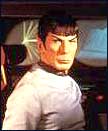 played
whenever they were on screen (Whitfield 375).
Mr. Spock's theme, for example, is played by ''an instrument that
couldn't possibly be romantic, a
bass guitar, down in the low register, with no resonance. It just
klunks out the theme'' (Karlin
20).
Star Trek Classic also played with the voices of alien characters.
They would electronically raise or lower the voices of
these actors to create an inhuman
effect. A dangerous cat woman in Star Trek V: The Final Frontier
has a voice made of real cat
noises mixed with distorted James Brown screams (Spomitz
44). To make ''alien'' languages sound real, they are sometimes
made from spliced-together bits of
exotic Earth languages, such as Gikuyu and Nepali. This causes
much hilarity when the movies
play in countries where these languages are spoken (Berger
130). played
whenever they were on screen (Whitfield 375).
Mr. Spock's theme, for example, is played by ''an instrument that
couldn't possibly be romantic, a
bass guitar, down in the low register, with no resonance. It just
klunks out the theme'' (Karlin
20).
Star Trek Classic also played with the voices of alien characters.
They would electronically raise or lower the voices of
these actors to create an inhuman
effect. A dangerous cat woman in Star Trek V: The Final Frontier
has a voice made of real cat
noises mixed with distorted James Brown screams (Spomitz
44). To make ''alien'' languages sound real, they are sometimes
made from spliced-together bits of
exotic Earth languages, such as Gikuyu and Nepali. This causes
much hilarity when the movies
play in countries where these languages are spoken (Berger
130).
Just as live characters are
accompanied by mechanical effects, sometimes machinery is given
a soundtrack that contains the sounds
of living beings. ''High-tech is boring,'' says effects mixer
Adam Jenkins,
who worked on the movie Star Trek Generations.
''And I don't mean that high-tech sounds are a bad thing. They're
just boring over time, and fatiguing on the brain. Which
is why we would consistently pull back on the telemetry tracks
[meaning the computer noises and high-tech-looking equipment].
Otherwise, it would begin to sound like a phone is ringing through
the entire scene'' (Kenny, ''Star Trek
Generations'' 78, 80)
For this reason, the effects
on Generations are surprisingly organic. Editors
used natural sounds -- birdsong, human voices, wind
noises -- all processed and mixed into the backgrounds, which
is critical on Star Trek, since so much of the action takes
place on the same ship, and if the
backgrounds aren't diverse enough, it will sound too homogenous
and claustrophobic. Of course,
sick bay sounds different from the bridge, which sounds different
from the more intimate confines of Whoopi Goldberg's
quarters or Captain Picard's stateroom (Kenny, ''Star
Trek Generations'' 80).
 The
definitive rumble of the starship Enterprise was invented
by sound effects creator Alan
Howarth, who has worked on every
Star Trek film. He created the ship's sound from a white
noise generator, plus an exhaust fan, plus the air conditioner
at Paramount Studios. Howarth
says, ''The bridge background of the 60's was electronic music
with sonar beeps. And our challenge
was to take these musical instruments and make sound effects --
without having them sound like a series of filters and
oscillators. They wanted the tracks
to be organic, to be more emotional and appealing. So, something
like the ship's ... phasers, was
a difficult effect, because it has to be pleasing, which we normally
associate with high end, and it has to be full-bandwidth
-- it has to have that low end
to give it size. It just so happened
that [for Star Trek Generations] we got two days of an
electronic storm in Southern California,
which is unusual in itself, and we recorded some very good lightning,
which worked as phasers.'' The
definitive rumble of the starship Enterprise was invented
by sound effects creator Alan
Howarth, who has worked on every
Star Trek film. He created the ship's sound from a white
noise generator, plus an exhaust fan, plus the air conditioner
at Paramount Studios. Howarth
says, ''The bridge background of the 60's was electronic music
with sonar beeps. And our challenge
was to take these musical instruments and make sound effects --
without having them sound like a series of filters and
oscillators. They wanted the tracks
to be organic, to be more emotional and appealing. So, something
like the ship's ... phasers, was
a difficult effect, because it has to be pleasing, which we normally
associate with high end, and it has to be full-bandwidth
-- it has to have that low end
to give it size. It just so happened
that [for Star Trek Generations] we got two days of an
electronic storm in Southern California,
which is unusual in itself, and we recorded some very good lightning,
which worked as phasers.''
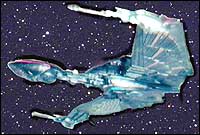 The
noise of the Klingon
bird-of-prey spaceship contains the songs of whales, ironically
enough. The mysterious Nexus energy wave which appears
at the climax of Generations combined more than 30 elements, including
animal cries to give it a subliminal sense of a living,
deadly creature (Kenny, ''Star Trek Generations''
78). When the Klingons destroy the Voyager probe in Star
Trek V, the explosion
contains the sounds of a woman's scream and the cartoon character
the Tasmanian Devil (Spotnitz 44). Another
unexpected organic quality can be
found in The Empire Strikes Back, in which a large door
was given no mechanical-sound basis
but does have a lion's growl buried subliminally in it (Berger
130). The
noise of the Klingon
bird-of-prey spaceship contains the songs of whales, ironically
enough. The mysterious Nexus energy wave which appears
at the climax of Generations combined more than 30 elements, including
animal cries to give it a subliminal sense of a living,
deadly creature (Kenny, ''Star Trek Generations''
78). When the Klingons destroy the Voyager probe in Star
Trek V, the explosion
contains the sounds of a woman's scream and the cartoon character
the Tasmanian Devil (Spotnitz 44). Another
unexpected organic quality can be
found in The Empire Strikes Back, in which a large door
was given no mechanical-sound basis
but does have a lion's growl buried subliminally in it (Berger
130).
There are plenty of other
surprises to be found in the sound studio, where a sound effect
is very often not what you think. More
information that Trekkers might like to know about their favorite
show is that the transporter's Beaming down sound is made
by piano wires strung across a literal beam (Kenny,
''Star Trek Generations'' 76). When you see the sliding
doors opening and closing, what you hear is a bunch of different
sounds including an air gun reversed and somebody's sneakers squeaking
on the floor to give it the rubber-seal effect (Kenny,
''Star Trek Generations'' 76). The photon torpedo blasts
don't sound like what they really are -- the recording of a Slinky
(Spotnitz 44).
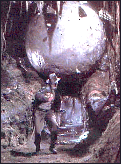 Raiders
of the Lost Ark opens with Indiana Jones fleeing a runaway
boulder. That noise was actually the sound editor's Honda Civic
rolling down his driveway (Spotnitz 42).
The light sabers in Star Wars are the sounds of a TV picture tube
and an old 35mm projector (Spotnitz 44).
Luke Skywalker's land cruiser is the noise of the Los Angeles
Harbor freeway traffic heard through a vacuumcleaner pipe (Spotnitz
44). Star Wars goes for gritty sounds, which is
why those movies sound like our world and Star Trek sounds
like a better one (Spotnitz 44). Raiders
of the Lost Ark opens with Indiana Jones fleeing a runaway
boulder. That noise was actually the sound editor's Honda Civic
rolling down his driveway (Spotnitz 42).
The light sabers in Star Wars are the sounds of a TV picture tube
and an old 35mm projector (Spotnitz 44).
Luke Skywalker's land cruiser is the noise of the Los Angeles
Harbor freeway traffic heard through a vacuumcleaner pipe (Spotnitz
44). Star Wars goes for gritty sounds, which is
why those movies sound like our world and Star Trek sounds
like a better one (Spotnitz 44).
The crew on Congo found
that the gorilla's natural cries weren't scary enough -- gorillas
actually make a soft, hooting noise, whereas the director wanted
a booming, Jurassic Park effect. So the post-production
men recorded the sound of howler monkeys, which do have a low,
throaty growl (Kenny, ''Sound for Three'' 83 --
84). Does that seem deflating? At least the sounds were
made by wild animals. The sound designer for Jumanji had
to come up with vocalizations for unusually intelligent and mischievous
monkeys from a wild, exotic, paradimensional world. What did he
use? His eight-year-old son (Kenny, ''Monkey Business''
113).
Though horror films can often
feature supernatural creatures and events, ironically enough what
they need is an uncomplicated sound that will disturb the audience
viscerally rather than interest them intellectually. You might
think I'm talking about sound effect libraries, of wolves growling
or boots stalking down an alleyway -- and you're right, soundtracks
do use these. But they also use much more mundane sounds. For
instance, the sound studios of horror movies are frequently littered
with fruits and vegetables
to make various body-snapping sound effects. The recent
Hellraiser IV went through a lot of melons (Stokes
74).
 Another
interesting monster sound was achieved in the made-for-TV
movie based on Stephen King's The Langoliers. The langoliers
are nearly all mouth, so they needed to have a predatory effect.
But King had described the sound of their approach as being reminiscent
of Rice Krispies. Although the langoliers, who literally eat the
world, would realistically require combinations of grinding, screeching,
scraping and the crunching of metal, pavement, and earth, the
executive producer was adamant
that they should not sound mechanical. Sound editor Ray
Palagy says, ''We actually spent an entire day recording cereal
sounds -- dry cereal, wet, mushy; in a bowl, in a tub
...'' They took all of these sounds and made processed versions
of all of them. Then they added effects such as Velcro, car doors,
subway screeches and lion growls to yield ''signature'' sounds
that are hard to categorize as animal or machine. Because supernatural
creatures such as the Langoliers are based on no equivalent in
the real world, they have to sound unique (Eskow
164). Another
interesting monster sound was achieved in the made-for-TV
movie based on Stephen King's The Langoliers. The langoliers
are nearly all mouth, so they needed to have a predatory effect.
But King had described the sound of their approach as being reminiscent
of Rice Krispies. Although the langoliers, who literally eat the
world, would realistically require combinations of grinding, screeching,
scraping and the crunching of metal, pavement, and earth, the
executive producer was adamant
that they should not sound mechanical. Sound editor Ray
Palagy says, ''We actually spent an entire day recording cereal
sounds -- dry cereal, wet, mushy; in a bowl, in a tub
...'' They took all of these sounds and made processed versions
of all of them. Then they added effects such as Velcro, car doors,
subway screeches and lion growls to yield ''signature'' sounds
that are hard to categorize as animal or machine. Because supernatural
creatures such as the Langoliers are based on no equivalent in
the real world, they have to sound unique (Eskow
164).
Another example of sound design
ingenuity can be found in the opening of Terminator 2.
The camera pans across burned-out car bodies and a devastated
playground from the year 2029 A.D. We hear a desolate wind ...
and then, CRUNCH! A robotic foot crushes a human skull. The sound
of the wind actually comes from the crack of an open door to the
main mix room at Skywalker Sound, combined with the sound artist
vocally going ''whoooooo.'' The sound of the crushed skull is
actually a
pistachio being crunched by a metal
plate (Kenny, ''T2'' 60 -- 61).
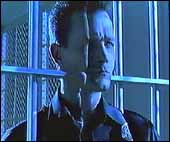 The
Terminator 2
sound crew got very inventive. They had to design the sound
of the T-1000 Terminator moving into and out of liquid metal,
the quality that makes him virtually indestructible. ''It's not
really liquid ...'' sound man Gary
Rydstrom says. ''It doesn't have any bubbles in it. It doesn't
gurgle. It doesn't do anything visually except flow like mercury
...'' So Rydstrom gathered a number of sound elements and played
them while watching the screen to see what sounded good. When
the T-1000 The
Terminator 2
sound crew got very inventive. They had to design the sound
of the T-1000 Terminator moving into and out of liquid metal,
the quality that makes him virtually indestructible. ''It's not
really liquid ...'' sound man Gary
Rydstrom says. ''It doesn't have any bubbles in it. It doesn't
gurgle. It doesn't do anything visually except flow like mercury
...'' So Rydstrom gathered a number of sound elements and played
them while watching the screen to see what sounded good. When
the T-1000
is just sort of flowing and transforming,
that's Rydstrom plunging a microphone covered with a condom into
a mixture he made of flour
and water with Dust-Off sprayed into it. ''It would make these
huge goopy bubbles,'' he says. ''And the moment when the bubble
is forming, it has this sound that's similar to a cappucino maker
... Funny enough, it had this metallic quality to it, so I believed
it for [the] transformation.''
For the sound of bullets hitting
T-1000, Rydstrom slammed an inverted glass into a bucket of yogurt,
getting a hard edge to accompany the goopy sound. In the psychiatric
prison where Sarah Connor is held prisoner, the
T-1000 flows around and through a gate of steel bars. That sound
is actually dog food being slowly sucked out of a can. ''A lot
of that I would play backward or do something to,'' Rydstrom says,
''but those were the basic elements. What's amazing to me is ...
Industrial Light & Magic using millions of dollars of high-tech
digital equipment and computers to come up with the visuals, and
meanwhile I'm inverting a dog food can'' (Kenny,
''T2'' 64)
So far it sounds like fun and
games, but sound mixers face a lot of difficulties beyond inventing
new sounds. One problem is trying to read the film director's
mind. Directors usually don't know anything about music scoring
and don't know how to articulate what kind of soundtrack they
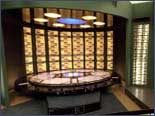 want.
For example, the producers of the Star Trek: Next Generation
TV show wanted the Enterprise transporter to sound like
its old recognizable self, but at the same time to sound more
high-tech and want.
For example, the producers of the Star Trek: Next Generation
TV show wanted the Enterprise transporter to sound like
its old recognizable self, but at the same time to sound more
high-tech and
intense. And Gene Roddenberry ordered
them to ''add a sense of mystery.'' So the sound mixers took the
basic musical chord and added
a series of tri-tones, performed on the Synclavier. By the time
Generations rolled around, the sound has changed
quite a bit, always finding some
new high-end sparkle to match the new opticals (Kenny,
''Star Trek Generations'' 76)
There is also the eternal problem
of the ''sound of space,'' an important point because technically,
there is no sound in space. ''But
it's a film, and you have to have something, so Howarth recorded
a couple of spring reverbs for that bwwooiiiinngg, and
played it back to create a crawling
effect'' (Kenny, ''Star Trek Generations'' 76).
We scientifically literate movie viewers will have
to put up with these things.
The sound crew of Generations
must have been amused when told that they were going to have to
create the sound of the Enterprise
crashing into a planet, destroying hundreds of feet of terrain,
and yet not totally self-destructing in the process. What
is the sound of a starship hitting a planet? The basic noise is
a recording of ''dry ice on bare metal, which gives this
annoying moaning, groaning, wrenching,
metallic sound.'' Then they added noises like earthquake rumbles,
cars skidding through gravel,
tree cracks, and explosions. ''The idea is to introduce variety
to sustain interest'' in the audience, who subconsciously
expect a variety of sounds to match the changing picture on screen
(Kenny, ''Star Trek Generations'' 78).
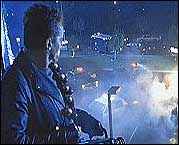 The
Terminator 2 sound crew faced a lot of challenges. In
one scene, Arnold Schwarzenegger participates in a major shootout
with the police outside the Cyberdyne
building. Sound man Gary Rydstrom says, ''The difficulty was that
[Arnold] is so in control
of shooting this gun, that the destruction he creates has to be
within reason. It has
to be such that you don't believe any cops are dying. So, we couldn't
use ricochets, because standard Hollywood ricochets
would imply that the bullets are flying out of control and killing
somebody. And we couldn't use explosions on the The
Terminator 2 sound crew faced a lot of challenges. In
one scene, Arnold Schwarzenegger participates in a major shootout
with the police outside the Cyberdyne
building. Sound man Gary Rydstrom says, ''The difficulty was that
[Arnold] is so in control
of shooting this gun, that the destruction he creates has to be
within reason. It has
to be such that you don't believe any cops are dying. So, we couldn't
use ricochets, because standard Hollywood ricochets
would imply that the bullets are flying out of control and killing
somebody. And we couldn't use explosions on the
cars, which look like they are exploding,
because they weren't exploding. They were just being demolished
to the point where they would
collapse. It was tricky to just use hits on metal, and glass [breaking]
... and ricochets that sounded like thuds'' (Kenny,
''T2'' 64).
Another major problem is
trying to get a clean recording of dialogue when your background
is noisy. The production sound mixers
for Congo found that ''Few shooting locations on the planet
can be more challenging ... than a tropical rain forest. It's
wet, even in the dry season. It's
hot. And the insects are big and loud, making it difficult to
pull clean dialog tracks out of the backgrounds.''
Mixer Ron Judkins,
who won an Academy Award for Jurassic Park, described it
as ''the most strenuous working
situation I've ever been in.'' And one location was right on the
edge of an extinct, but still hissing volcano crater
(Kenny, ''Sound for
Three,'' 76).
 The
sound effects team for The X-Files needs a sense of
humor too. ''The biggest difference between this show and other
shows,'' says production mixer Michael
Williamson, ''is that UFOs never land in the middle of the
city during the daytime. They always
land in the middle of mountains or out in the water, and it has
to be raining, and it has to be muddy, and it has
to be windy, so those are
the problems we have. If we're out in the bush and they decide
they want to have wind blowing through the trees,
we have to try [to] isolate the dialogue to a point where you
don't hear the wind machine.'' (Moshansky 93).
He adds, ''Another thing is
that it never fails that our lead actor [David Duchovny] gets
beaten up, and ... that brings a whole host of new problems.
If you're in a very wild environment and there's lightning machines
going off and rain towers spreading rain all over the
place and wind machines going nuts, and the only way you can really
get good, solid, clean sound is by putting a wireless on
a guy, and he's got to go into a
fight, then all of a sudden, the wireless isn't going to be any
good. Everything is a challenge'' (Moshansky
91). The
sound effects team for The X-Files needs a sense of
humor too. ''The biggest difference between this show and other
shows,'' says production mixer Michael
Williamson, ''is that UFOs never land in the middle of the
city during the daytime. They always
land in the middle of mountains or out in the water, and it has
to be raining, and it has to be muddy, and it has
to be windy, so those are
the problems we have. If we're out in the bush and they decide
they want to have wind blowing through the trees,
we have to try [to] isolate the dialogue to a point where you
don't hear the wind machine.'' (Moshansky 93).
He adds, ''Another thing is
that it never fails that our lead actor [David Duchovny] gets
beaten up, and ... that brings a whole host of new problems.
If you're in a very wild environment and there's lightning machines
going off and rain towers spreading rain all over the
place and wind machines going nuts, and the only way you can really
get good, solid, clean sound is by putting a wireless on
a guy, and he's got to go into a
fight, then all of a sudden, the wireless isn't going to be any
good. Everything is a challenge'' (Moshansky
91).
So next time when you go
to the movies, give the sound effects a round of applause. Rydstrom,
sound designer for Terminator 2,
says, ''Your first thought when you see a lot of special effects
is that sound's job is to not only do something as fantastical
as the visual, but also to
make it real. It's not competing with the special visual
effect, because people perceive the visual and the sound
differently. [Sound designer] Walter
Murch had a way of putting it: The eyes are the front door,
and the ears are the back
door'' (Kenny, ''T2'' 61).
But one thing is certain:
As visual effects for movies become more and more sophisticated,
we can be sure that sound effects will
need to be more and more inventive -- even if it's only to think
of things to do with a condom, yogurt, or a dog food can.
As Tamara Rogers, a sound expert
in Hollywood, puts it, ''audio is the last frontier'' (Stokes
77).
Works Cited
Bazelon, Irwin. Knowing the Score: Notes on Film
Music. New York: Van Nostrand Reinhold, 1975.
Berger, Ivan. ''Soundtrack of the Lost Ark'' in
Audio 68.11 (Nov. 1984): 130.
Blake, Larry.
''Sound for Film: Go Back and Listen: Classic Film Sound Tracks''
in Mix: Professional Recording * Sound and
Music Production 19.8 (August 1995): 110.
Darby, William
and Jack Du Bois. American Film Music: Major Composers. Techniques,
Trends, 1915 -- 1990. Jefferson, NC:
McFarland & Co., 1990.
Droney, Maureen.
''John Carpenter: One-Stop Movie Shop'' in Mix: Professional Recording
* Sound and Music Production
19.12 (December 1995): 109, 112 -- 118.
Eskow, Gary.
''Animal Meets Machine: Sound for The Langoliers'' in Mix: Professional
Recording * Sound and Music Production
19.5 (May 1995): 157, 162 -- 164, 197.
Kalinak,
Kathryn. Settling the Score: Music and the Classical Hollywood
Film. Madison: U of Wisconsin P, 1992.
Karlin, Fred.
Listening to Movies: The Film Lover's Guide to Film Music. New
York: Schirmer, 1994.
Kenny, Tom.
''Monkey Business: Vocalizations for Jumanji'' in Mix: Professional
Recording * Sound and Music Production 20.3
(March 1996): 113, 118.
Kenny, Tom.
''Sound for Three Summer Blockbusters'' in Mix: Professional Recording
* Sound and Music Production 19.6
(June 1995): 76 -- 86.
Kenny, Tom.
''Star Trek Generations'' in Mix: Professional Recording * Sound
and Music Production 19.1 (January 1995): 72
-- 83.
Kenny, Tom.
''T2: Behind the Scenes with the Terminator 2 Sound Team'' in
Mix: Professional Recording * Sound and Music
Production 15.9 (September 1991): 60 -- 62, 64, 66, 116.
Moshansky,
Tim. ''The X-Files Files'' in Mix: Professional Recording * Sound
and Music Production 19.6 (June 1995): 89, 91
-- 93, 216.
Spotnitz,
Frank. ''Stick it in your Ear'' in American Film 15.1 (October
1989): 40 -- 45.
Stokes, Jim.
''Using Sound Effects: Foley'' in Post: The International Magazine
for Post Production Professionals 10.10 (Oct.
16, 1995): 73 -- 84.
Whitfield,
Stephen E. and Gene Roddenberry. The Making of Star Trek. New
York: Ballantine Books, 1968.
Sound Effects in SF and
Horror Films," in Kongressbok ConFuse 96, the program booklet for
the SF convention held in Linköping, Sweden, June 14 -16, 1996,
p. 44-50.
>>
To
Fiona Kelleghan's Home Page
>>
Sound Design of Sci-Fi
Films
Original URL:
http://www.lysator.liu.se/lsff/confuse96/Sound_Effects_in_SF_and_Horror_Films.html
|